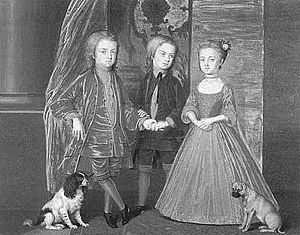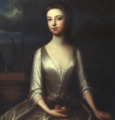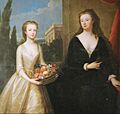Diana Russell, Duchess of Bedford facts for kids
Quick facts for kids
Diana Russell
|
|
|---|---|
| Duchess of Bedford | |
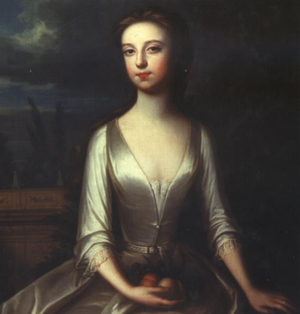
Portrait of Lady Diana painted by Charles Jervas while she lived in Blenheim Palace
|
|
| Born | Lady Diana Spencer 31 July 1710 London, England |
| Died | 27 September 1735 (aged 25) Bedford House (Strand) (formerly called Southampton House), Bloomsbury Square, Bedford Estate, London, England |
| Cause of death | Tuberculosis |
| Noble family | Spencer (by birth) Russell (by marriage) |
| Spouse(s) | |
| Issue | John Russell, Marquess of Tavistock |
| Father | Charles Spencer, 3rd Earl of Sunderland |
| Mother | Lady Anne Churchill |
Diana Russell, Duchess of Bedford (born Lady Diana Spencer; 31 July 1710 – 27 September 1735) was an important member of the Spencer family. People mainly remember her because of a plan to arrange her marriage to Frederick, Prince of Wales, who was the son of the King. This plan did not work out.
Diana became an orphan when she was only six years old. Her family called her "dear little Di." She then went to live with her wealthy and determined grandmother, Sarah Churchill, Duchess of Marlborough. Her grandmother loved her very much and trusted her with secrets. The Duchess of Marlborough was a very powerful woman. She tried to arrange a secret marriage between Lady Diana and the Prince of Wales. He was King George II's oldest son and would one day become king.
However, the Prime Minister, Robert Walpole, stopped this plan. After that, Lady Diana married Lord John Russell, who later became the 4th Duke of Bedford. They had one son named John, who was born too early after a carriage accident and lived for only one day. After another pregnancy loss, the Duchess of Bedford died from tuberculosis when she was 25 years old.
Many years later, in 1981, another Lady Diana Spencer married Charles, Prince of Wales. She was a descendant of Lady Diana Russell's brother, John. This later Lady Diana was named after the Duchess of Bedford.
Contents
Diana's Childhood and Family Life

Lady Diana Spencer was born in London on July 31, 1710. She was part of the growing Spencer family. She was the second daughter and the youngest of five children. Her father was Charles Spencer, 3rd Earl of Sunderland, a British statesman. Her mother was Anne Spencer, Countess of Sunderland.
Diana's mother was the favorite daughter of John Churchill, 1st Duke of Marlborough. He was a famous soldier and statesman. Diana's grandmother, Sarah Churchill, Duchess of Marlborough, was also very powerful. She was a close friend of Queen Anne, who died in 1714.
Diana's mother died on April 29, 1716. Her father then married his third wife, Judith Tichborne, in December 1716. They had three children who died when they were babies. Diana's father died on April 19, 1722. The Duke of Marlborough also died in June of the same year.
After her mother died, Diana's grandmother, the Dowager Duchess of Marlborough, helped raise Diana and her siblings. When their father died, the Dowager Duchess became fully responsible for the children.
Diana's family called her "dear little Di." As she grew up, she became a tall, fair-haired, and beautiful young woman. People who knew her thought she was kind and charming. She often helped her grandmother by writing letters because her grandmother had gout and found it hard to write. In 1723, her grandmother said Diana had "more sense than anybody I know of my sex." Diana also lived near the famous composer George Frideric Handel. This made her love opera for her whole life.
Marriage Plans and a Royal Match
When Lady Diana was a teenager, many important men wanted to marry her. She was considered a top choice for marriage because she was beautiful and very close to her incredibly rich grandmother. The Duke of Somerset tried to arrange for her to marry his grandson. Other noblemen, like the Viscount Weymouth and the Earl of Shaftesbury, also wanted to marry her.
The middle-aged Earl of Chesterfield was already liked by Diana's grandmother. He proposed marriage in a letter to the Dowager Duchess on August 14, 1731. He wrote that Diana's looks, good qualities, and family were very valuable. However, the Dowager Duchess turned him down too. She was waiting for a very rich husband with a noble title and the right political views. This waiting almost caused a problem when Lady Diana got a skin condition. Her grandmother had to pay a famous surgeon to hide the marks from this illness.
Lady Diana spent her early years close to the children of King George II. Even though her grandmother and the King's family were not always close at first, their connection grew stronger in the 1730s. Soon, rumors spread that the Dowager Duchess was planning a secret marriage between Diana and the King's oldest son, Frederick, Prince of Wales. He was the heir apparent to the throne, but he and his father did not get along well.
The secret wedding was supposed to happen in a lodge at Windsor Great Park. A date was even agreed upon. The Dowager Duchess offered the Prince of Wales £100,000 because he was deeply in debt. This money was for him to agree to the marriage. However, Prime Minister Robert Walpole preferred the Prince to marry someone from a European royal family. He found out about the secret plan through his "infallible spy system" and stopped the marriage. This made his bad relationship with the Dowager Duchess even worse. This story was only written down many years later by Walpole's son, Horace.
Diana's Marriage and Motherhood
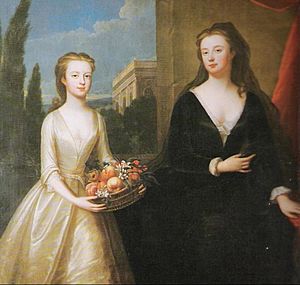
After the royal marriage plan failed, the Dowager Duchess finally chose 21-year-old Lord John Russell. He was the younger brother of the Duke of Bedford. Lady Diana and Lord John married on October 11, 1731. She brought a dowry of £30,000, and her grandmother promised another £100,000 when she died. The Dowager Duchess likely hoped that her grandson-in-law would become the Duke of Bedford, which he did. When his brother-in-law died in Spain on October 23, 1732, Lady Diana became the Duchess of Bedford. She also became the lady of Woburn Abbey.
News of her brother-in-law's death had not yet reached England. In early November, the pregnant Duchess was thrown from her carriage. This accident caused her to give premature birth to a son named John. He was possibly born in Cheam. His baptism was recorded on November 6, but he died within a day. He was buried in Chenies on November 11. Lord Hervey reported that it was very important to keep the news of the baby's death from the Duchess. So, after a long discussion, they decided to bring another baby to replace the one who died. They would tell her the truth only when she was strong enough.
The Duke really wanted to have a son who would inherit his title. He was very upset when, a few months after their son's birth, the Duchess had another pregnancy loss. The Duchess was blamed for not taking care of herself properly during that pregnancy.
Even though they no longer lived together, Diana and her grandmother saw each other often. They also wrote two or three letters every week when they were apart. The Duchess of Bedford remained her grandmother's closest friend. She was told about all family matters, including money issues.
Diana's Final Years
In the spring of 1735, the Duchess of Bedford started feeling sick. She thought she was pregnant for the third time. It is not clear if she was actually pregnant, but soon it became clear that she had tuberculosis. This illness got worse quickly. The Duchess was losing a lot of weight instead of gaining it. Her grandmother insisted that Diana be moved to Bedford House in Bloomsbury Square.
Diana died there on September 27, 1735, at the age of 25. She did not leave a will and had no surviving children.
Her grandmother was heartbroken. She reread and burned all of Diana's letters. She also blamed Diana's husband for her death. Even though she usually did not show strong religious feelings, the Dowager Duchess of Marlborough reportedly prayed on the floor of Marlborough House when her favorite grandchild died. She had grown apart from all her other daughters. The Duchess of Bedford was her only grandchild who never disappointed her. However, Lord Hervey said that the Dowager Duchess cared more about getting back her granddaughter's jewels. She demanded them from the Duke even before Diana was buried.
The Duchess of Bedford's coffin, which was lined with lead, was carried on a gun carriage through the streets. She was buried on October 9, 1735, in Chenies, Buckinghamshire. Her death meant her grandmother no longer had a strong connection to the Duke of Bedford. This made the Duke's influence much less.
Diana's Lasting Impact
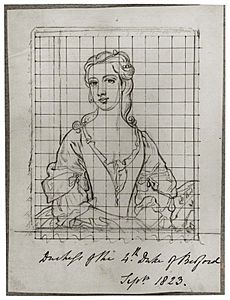
Wimbledon House was a property Diana was supposed to inherit from her grandmother. Instead, it went to her brother, John, who was her grandmother's favorite grandson. In 1961, John's descendant, Viscount Althorp, had a daughter. Her name was chosen a week after she was born. She was christened Diana, named after the Duchess of Bedford.
Unlike her ancestor, the 20th-century Lady Diana Spencer did marry her Prince of Wales, Charles, in 1981. She died in 1997, at age 36, a year after their divorce. Victoria Massey, who wrote a book about the earlier Lady Diana Spencer, noticed many similarities between the two women's lives. Both lived at Althorp as children and spent time with royalty. Both grew up without their mothers from the age of six. Both were suggested as brides for a Prince of Wales. Both had an accident during their first pregnancy. And both died unexpectedly when they were young.
Images for kids
-
Portrait of Lady Diana painted by Charles Jervas while she lived in Blenheim Palace
-
Lady Sunderland and Lady Diana, by Sir Godfrey Kneller
-
Bernard Lens's 1720 portrait of Diana and her brothers Charles and John
-
The Dowager Duchess of Marlborough and Lady Diana Spencer, by Maria Verelst
-
Portrait by Thomas Hudson, still hanging in Woburn Abbey
-
Pencil drawing by Henry Bone, September 1823


